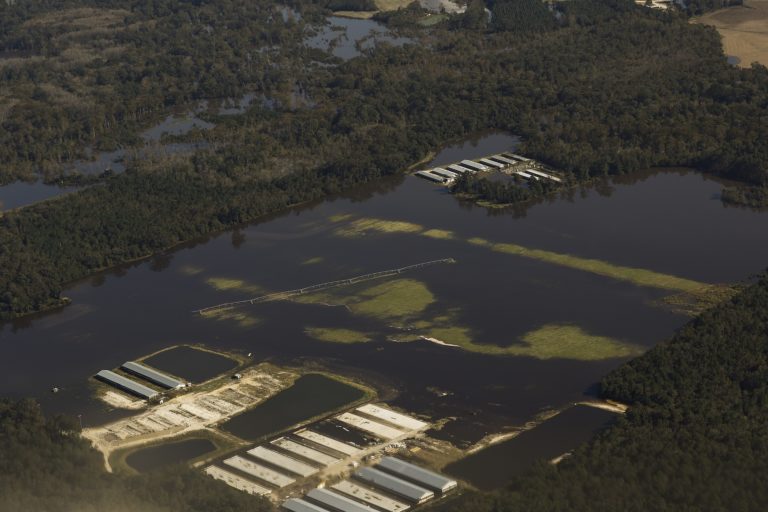Waterkeeper Alliance and North Carolina Riverkeepers Conduct Aerial Patrols, Document Hog Waste Contamination and Flooded Coal Ash Ponds
By: Waterkeeper Alliance

RALEIGH, NORTH CAROLINA — Waterkeeper Alliance continues to activate its Rapid Response protocol with 13 North Carolina Riverkeeper organizations to document the serious flooding impacts in the wake of Hurricane Matthew from the ground, in the air and on the water.
Aerial patrols conducted October 12 and 13 over concentrated animal feeding operations (CAFOs) have shown the following:
- Floodwaters are running through poultry confinement buildings, killing the animals inside and washing their untreated feces and urine downstream. Even after the floodwaters subside, the issue of disposal of such large numbers of dead animals will present a serious issue.
- Hog waste lagoons (cesspools) are being flooded and their untreated contents containing dangerous bacteria and viruses are also headed downstream. Toxic animal waste is now running down streams and rivers and polluting the groundwater.
- Many rivers and streams in eastern North Carolina have been impacted.
- In the Neuse River watershed alone, more than six flooded and/or breached hog waste lagoons have been recorded. Some lagoons are so far submerged under flood waters that they can not be seen from the air.
- In the Trent River watershed in Jones county, the floodwaters are threatening a number of hog lagoons, especially near Trenton.
- In the Northeast Cape Fear River upstream from Kenansville many poultry facilities are flooded. The floodwaters are also threatening many swine waste lagoons but, so far, none were observed discharging in this area.
- Near Contentnea Creek, several waste lagoons were badly flooded.
- Hog CAFOs have been documented spraying untreated animal waste from their lagoons, which violates state permits for CAFO facilities.
Coal Ash/Power Plants
- On Sunday, October 9, the Neuse River overtopped three coal ash ponds at Duke Energy’s H. F. Lee power plant near Goldsboro. More than a million tons of exposed coal ash remains completely underwater. Flood waters continue to threaten the 20-foot dams around a fourth coal ash pond containing an additional 3.8 million tons of ash.
- The dam of a 1.2-billion-gallon cooling pond at the H. F. Lee facility ruptured on Tuesday. Unaware of a 50-foot rupture in the dam for upwards of 24 hours, Duke Energy issued a statement on Wednesday touting the continued safe operation of its dams before a local reporter informed the company of the dam breach.
Waterkeeper Alliance and the North Carolina Riverkeepers will continue to document environmental threats posed in these areas and urge the State to accurately inform the public and take the appropriate regulatory response.
** To arrange interviews with Waterkeeper Alliance staff and North Carolina Riverkeepers on the ground and in the air in their areas monitoring the conditions, contact: Tina Posterli, Waterkeeper Alliance, 516-526-9371, [email protected]
Click here to read about our North Carolina “Fields of Filth” report and connect to a map of all the poultry and swine farms in North Carolina.
The Waterkeeper Alliance Rapid Response Team initiative is an innovative solution that provides trusted and independent emergency response to disasters on our waterways. In a climate of lax federal regulations and extensive budget cuts to state departments of environmental conservation, the need for Waterkeepers to speak truth about the devastating impacts of water emergencies on communities has never been greater. North Carolina Riverkeepers will remain involved as long as necessary in order assure that proper clean-up, mitigation and enforcement is completed.